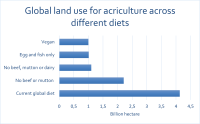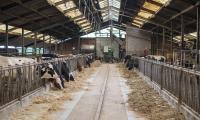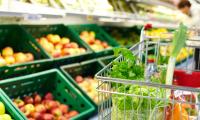We can avert a looming food crisis by accelerating the green transition of the food system
To avoid further disasters, we must choose the right solutions to the looming global food crisis. The EU and Denmark should accelerate the shift to land-efficient food production and consumption and reduce the use of crops for energy
While the latest UN climate panel (IPCC) report has just highlighted the fragility of global agricultural production, a global food crisis is now also looming in the wake of the terrible war in Ukraine. The UN Food and Agriculture Organisation (FAO) predicts that the uncertainty in the global food system will worsen significantly.
Ukraine and Russia account for about 24% of the world's exports of cereal crops, especially wheat, and are also the world's biggest exporters of sunflower oil. The war affects production and increases global food prices, which were already at high levels. According to the FAO food price index, prices are now at their highest ever. It threatens global food security, and in order to fight poverty and hunger and safeguard climate, nature, and biodiversity, it is crucial that we choose the right solutions now to avoid further disasters.
A food crisis, like climate change, will hit the most vulnerable first and hardest, both domestically and in developing countries. But a food crisis could also lead to new conflicts, which could later have significant consequences for Denmark and the EU, such as new wars and refugee flows. So, while it may be easier to save energy, it is at least as important to save agricultural land, and it is precisely now that it is crucial to make the right choices to find a fair, long-term, and sustainable way out of the crisis.
A food crisis will impact people, nature, and climate globally as well as locally. As food becomes more expensive, nature and forests may be cleared to make way for agricultural production. And if food supplies do not increase, this could lead to famine and new conflicts in the world.
Several politicians and farming organizations in the EU and Denmark have already proposed using fallow land to produce protein crops for feed in livestock production, as shortages could quickly arise. But this is not an appropriate way forward. We can produce more food for more people if agriculture focuses on producing crops for people. At the same time, it would also be better for the climate if livestock production were reduced.
Food system in a negative spiral
According to the IPCC's latest report, climate-related extreme weather events such as droughts, floods, and forest fires have negatively affected agricultural productivity, reduced food supply, raised food prices, and threatened livelihoods and food access for millions of people. Crop production, in particular, has been negatively affected.
According to the IPCC, global agricultural productivity growth has slowed by 21% since 1961. In Africa alone, growth has declined by as much as 34% since 1961, which is a major reason why 250 million people in Africa are currently malnourished.
The IPCC points out how diets based on meat contribute to the fragility of the earth's ecosystems as nature is cleared to make way for agriculture. We are thus in a negative spiral, where agricultural production negatively affects the climate, and climate change affects agriculture. This could lead to further expansion of agricultural land to ensure food security. Thus, more nature will be cleared, emitting more greenhouse gases and contributing to further climate change. At the same time, the IPCC describes that the opportunities to adapt agricultural production to a warmer climate become smaller the warmer it gets. This is generally an unsustainable situation.
Substantial expansion of the global agricultural area
With 40% more people expected in the world in 2050 than in 2010 and a larger middle class, WRI estimates that agricultural land will potentially need to expand by an additional 600 million hectares to feed the world's population based on current food production and demand. That is about 140 times the total land area of Denmark. This would be catastrophic for nature, the climate, and those who live in and from nature.
However, it is not only food that has increased the demand for agricultural land. It is also the production of biomass for bioenergy, e.g., energy crops for biofuels and biogas. Biomass is produced on agricultural land, which takes up a significant additional area. The Swiss Scientific Committee on the Environment (SCOPE) has estimated that around 200 million hectares will be needed for this purpose by 2050. This could also contribute to deforestation and thus additional greenhouse gas emissions. The IPCC warns against large-scale production of crops for bioenergy, as it could lead to water shortages, reduce food security and negatively affect biodiversity.
Need for land-efficient production of food and energy
Just as the war in Ukraine has increased the focus on saving energy, policymakers, businesses, and civil society alike can do more to mitigate the global food crisis by being much more land-efficient in our food production and consumption.
Fortunately, there is a good fit between many of the policies that will secure global food supply while preventing and reducing climate change. However, this requires a readiness to use policy tools that have not been fully recognized and implemented yet.
One way to ensure land-efficient food production is through a balanced diet, as described by the IPCC. For Denmark and the rest of the EU, it means eating less animal-based food, especially those based on ruminants such as cattle and sheep. In addition, there must be a greater focus on increasing yields on existing agricultural land.
Finally, it is also important to reduce food waste and food losses. The FAO estimates that 1.4 billion hectares of farmland, equivalent to about a third of current agricultural land, is currently used to produce food that is not eaten.
With a balanced diet and less food waste, we can reduce the demand on agricultural land for food production and mitigate the global food crisis.
According to a study by Poore & Nemecek, the figure below shows how many billion hectares of global agricultural land could be reduced under different dietary scenarios, according to a study by Poore & Nemecek. It is worth noting that just stopping eating beef, lamb and mutton could reduce land demand by as much as 46%. Cutting all beef, lamb and mutton plus dairy could reduce land use by as much as 73%. The biggest reduction, according to the study, would come from an entirely plant-based diet. So, with the current amount of land, we could feed many more people with diets not based on beef, lamb, and mutton because that would free up space to produce much more food.

Land use in billion hectares for different dietary scenarios. Source: Our World in Data.
In addition, efforts should be made to reduce the consumption of crops for energy. In the context of implementing the EU biofuels regulation, the 6% CO2e reduction requirement for petrol, diesel, and gas means that a significant amount of biofuel is used in transport. This means we use agricultural land to produce fuels instead of food - increasing food prices and reducing food security.
An appropriate EU response to the current critical food supply situation could be an immediate change to the CO2e reduction requirement to be met to a much lesser extent by biofuels.
In addition, more people using public transport, reducing road speeds, carpooling, or replacing the fossil car with an electric one would help mitigate the looming food crisis and be good for the climate. These measures reduce the demand for biofuels and make room for more food production.






